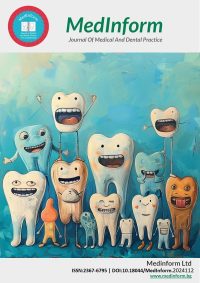Issue Two 2024
2024, Vol. 11, issue 2, (July)
Original Article
Oral hygiene habits in adolescents with disturbаnces in the nutritional status
Abstract:
AIM: The aim of the study is to determine the quality of oral hygiene in adolescents aged between 11-17 years with disturbances in the nutritional status.
Material and Methods: The study was conducted in 2023-2024. 300 children participated in the study, of which 157 (52.3%) were boys with a median age of 13 years, and 143 (47.6%) were girls with a median age of 14 years. An analysis of the nutritional status of the examined children was made using the BMI-Z Percentile anthropometric indicator. Adolescents were divided into 2 groups: first-normal body weight, second-with disturbed nutritional status. With the help of a survey, the means, frequency and duration of oral hygiene of the examined children were determined. The DMFT index was used to evaluate the teeth affected by the carious process. To assess oral hygiene and gingival inflammation, we used OHI-S and GI.
Results: There is a difference between the DMFT index in girls and boys with impaired nutritional status, with the median in girls being 6 (4-9), and in boys – 4 (3-6), (p<0.001). Of the total number of examined children, 60.3% have a disturbed nutritional status, of which 9% are overweight, and 51.3% are at risk of obesity. 39.7% are of normal body weight. No statistically significant difference was found in the values of OHI-S (p<0.298) and GI (p<0.423) in the two studied groups. Unsatisfactory oral-hygiene habits are registered among those with disturbances in the nutritional status: 86.2% of them brush their teeth only in the morning, and in 66.9% the procedure lasts less than 1 minute. 84.3% of these children use a manual toothbrush and only 0.6% use toothpaste and dental floss.
Conclusion: Poor oral hygiene habits in the two groups of children studied led to a greater prevalence of caries.
Keywords: oral hygiene, adolescent, nutritional status, carious process, gingival inflammation
Authors:
Kristiyana Mineva; Department of Pediatric Dentistry, Faculty of Dental Medicine, Medical University-Varna, Bulgaria; Email this authorMilena Georgieva-Dimitrova; Department of Pediatric Dentistry, Faculty of Dental Medicine, Medical University-Varna, Bulgaria;
Anzhela Bakhova; Faculty of Public Health, Medical University of Varna, Varna, Bulgaria;

